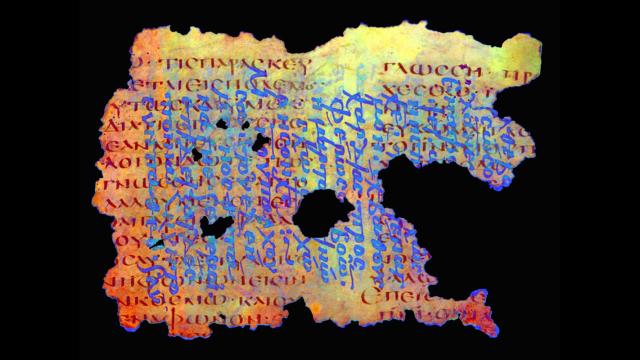Historical documents considered lost to the ravages of time, like crumbling parchment thousands of years old or medieval manuscripts whose ink long ago faded away, are being given a new life thanks to a technology known as multispectral imaging. The sophisticated tech requires specialised training and expensive equipment, but researchers have recently been trying to make its use more widespread.
In March, scientists from the Rochester Institute of Technology (RIT) in the U.S. brought one of MegaVision’s multispectral imaging systems to Dubrovnik to demonstrate to conservationists, researchers, and government officials how the technology can be deployed to reveal ancient text and preserve fading medieval manuscripts.
Dubrovnik, the city in Croatia whose 13th century city walls have been used in Game of Thrones, has about 30,000 medieval manuscripts, according to David Messinger, who headed up the project for RIT’s Center for Imaging Science.
“We have a campus over there,” Messinger told Gizmodo. “So this was like a first contact workshop to show them in a hands-on way what the tech could do.”
What multispectral imaging can do in some cases has been impressive.
Digital camera sensors are fundamentally multispectral sensors to begin with, meaning that they can detect light outside the visible wavelengths. Multispectral systems, such as MegaVision’s EV package, take advantage of this property and use high-resolution 50-megapixel sensors and computer-controlled cameras with LED lighting systems to take photographs in the ultraviolet, infrared, and visible spectra, creating dozens of images of a fragment in different reflective wavelengths.
“It is this kind of fluorescence imaging that can reveal the presence of ink even if it is scraped away because those areas suppress the fluorescence,” said Messinger. It can literally make invisible text visible again, and in the process change our view of history.
One of the most startling projects involving multispectral imaging is the continuing work by the Israel Antiquity Authority on the Dead Sea Scrolls. The scrolls, over 2000 years old, are actually a collection of more than 900 different texts in tens of thousands of fragments.
They were originally discovered in a series of 12 caves in the desert near Qumran in the mid 1940s and 1950s. The texts include the earliest copies of books from the Torah and the Old Testament.
But deciphering all the parchment was nearly impossible, primarily because many of the writings in Greek, Aramaic, and paleo-Hebrew had lost the visible ink over the centuries or had turned black because of exposure to the elements.
Multispectral imaging changed all that, allowing scholars to see text and read words not seen by human eyes in several millennium. Last year, a study of one fragment using multispectral imaging revealed that it was from a previously unknown text.
Similar camera systems have been used to reveal words that Thomas Jefferson rubbed out and changed on an original draft of the Declaration of Independence.
Other researchers have use the technology to reveal forged works, such as a purported copy of a work known as John’s Gospel. Researchers have even discovered a palimpsest of a manuscript of Archimedes’ principles that had been erased and overwritten with the text of a Christian prayer book.
Some of the most controversial discoveries may have yet to be made using such technology.
In an obscure monastery in the Sinai peninsula, a team is now using a MegaVision multispectral imaging system to examine and catalogue scores of palimpsests dating back to the 4th century.
Many of the erased texts have never been seen or studied by scholars before. And the work has been closely watched, not least because St. Catherine’s Monastery was where the contested “Secret Mark” text that was supposedly redacted from the canonical Gospel of Mark was discovered.
So did Messinger’s team from RIT discover anything as controversial in any Croatian manuscripts?
“We were only looking at binding fragments (pieces of a manuscript recycled to bind another book),” said Messinger, “and what we imaged and processed was in Latin, so we don’t know what it actually said.”
Messinger is more focused on getting the technology in the hands of other scholars to do the translating, including getting the Croatian government to help fund a permanent multispectral imaging system in Dubrovnik. But Messinger acknowledged that such systems are still expensive, costing around $110,000 and up.
The hope, of course, is that by spreading the gospel of multispectral imaging, its use will become more widespread. Aside from making invisible “lost” text visible once again, the technology can help determine the authenticity of some texts (by identifying the kind of ink used, for example), as well as conduct dating analysis on rare material in a non-destructive manner. (Widely used carbon dating involves destroying some part of the original material in the process.)
And the resulting pictures from multispectral imaging amount to a digital database, preserving priceless ancient documents for future study.
Making multispectral technology commonplace will require lower-priced equipment for researchers to decipher ancient texts stored in remote caches around the world. Currently, MegaVision has one system that fits into two large suitcases and takes about half a day for an experienced technician to set up. Going forward, though, Messinger thinks that models with fewer features could be made more portable and available for around $7100.
With such tools at their disposal, who knows what lost manuscripts might be found in the future?
JQ writes about science and technology and is the editor-in-chief of OntheRoadtoAutonomy.com@jqontech.
